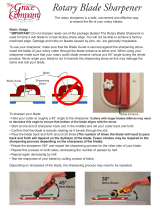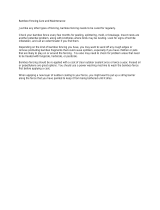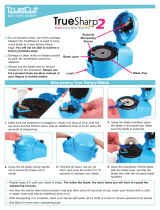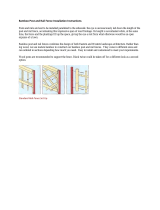Page is loading ...

No. 675 24" Carpet tile Cutter
SAFETY FIRST - read and save all instructions!
The Crain 24" Carpet Tile Cutter includes a 26" blade designed to cut soft tiles
including carpet tiles, VCT tiles, luxury vinyl tiles, rubber tiles and cork tiles.
Do not use the 26" blade for cutting wood or laminate planks, or ceramic tiles.
A 13" wood cutting blade is available for cutting wood and laminate ooring
planks only (not shingles or wall siding), and is sold separately. Do not use this
cutter for any purpose not described in this manual.
This cutter has a sharp blade. Keep hands away! The blade is lever-activated
and can cause severe cuts or sever ngers or hands. Pay attention to the posi-
tion and motion of the blade in operation and transportation of the cutter.
If the material being cut gets stuck on the blade, remove the stuck material
from the blade using scrap material or other tool. Do not use bare hands! Keep
hands away from the blade at all times. Use of new, clean, sharp blades can
reduce the sticking of materials on the blade.
Scrap materials, dust, and splinters can accumulate around the blade, behind
the blade, or on the bed of the cutter. These can impair the safe operation of
the cutter. Keep these clear at all times by dusting them off using a piece of
scrap material or other tool. Keep hands away from the blade. Wear eye and
ear protection when using this cutter.
INSTRUCTIONS FOR
Carrying
Handle
Rear
Stand
Ruler
Cut Guide
Fence
Bottom
Bar
Blade
Pressure
Roller
Pressure
Roller
Blade
Carrier
Safety
Lock
Connector
Tube
Leverage
Handle
Grip
Bed
Guide
Post
•
T
h
i
n
k
S
a
f
e
t
y
•
W
e
a
r
E
y
e
P
r
o
t
e
c
t
i
o
n
CRAIN
KEEP HANDS
AWAY FROM:
WARNING!
BLADE
BLADE CARRIER
PRESSURE ROLLERS
Figure 1

2
The cutting operation may leave splinters or sharp edges on the material that is
being cut. Some materials may require sanding before nal installation. Inspect
all cuts prior to installation. Do not install cut pieces with splinters or sharp edg-
es. Keep splinters and cut pieces with sharp edges out of the work area.
This cutter has two pressure rollers that can pinch and crush ngers or hands.
Keep hands away! Keep ngers and hands out from under the blade carrier,
as they can be crushed against the material being cut, or the bed of the cutter.
The cutter has a safety lock that holds the leverage handle and the blade in the
down position. For protection, lock the safety lock whenever the cutter is not in
use. Also, lock the safety lock whenever the cutter is being transported or placed
in storage. To lock the safety lock, move the handle to the down position, then
slide the safety lock to the far right (Figure 3). When the safety lock is locked,
tighten the safety lock’s lock nut to x the safety lock in locked position.
This cutter has a spring-loaded leverage handle that rises automatically with
enough force to cause injury (Figure 4). Be aware of the motion of the leverage
handle. As it rises, guide the leverage handle to its starting upright position to
prevent it from slamming against its stop or impacting your body. In operation,
kneel to the side of the leverage handle, keeping head and body out of its arc.
This cutter is not to be used by children or persons with reduced physical, sen-
sory or mental ability, or that lack experience and knowledge, unless they have
been given supervision or instruction.
Keep the work area clean. Clutter invites accidents. The work environment
should be clean, dry, well lit, and clear of any ammable materials or explosive
gasses. Do not use the cutter in wet or damp conditions. Keep children and
bystanders away from the cutter and out of the work area.
This cutter is a ooring tool for use on the oor only. It has a spring-loaded
leverage handle that generates a lot of force and can cause motion such as
tipping of the cutter. Do not use the tool on a table that can tip and cause the
cutter to fall, or anywhere near stairs or balconies from which it may fall.
Keep blades clean and sharp. Dull blades can require excessive cutting force,
which may result in increased risk of injury, or damage to the tool.
LOCK
NUT
Figure 2 - Unlocked Figure 3 - Locked Figure 4

3
CAUTION: Do not apply excessive force to the cutter, as this can cause injuries,
including back injuries, or damage the cutter. Don’t alter the cutter by using
attachments such as extended leverage handles or other power sources. Dam-
age or injury may result. Use only Crain replacement blades for this cutter.
Some dust created by cutting contains chemicals that can be injurious to your
health, including formaldehyde. Work in a well-ventilated area, and work with
approved safety equipment. If necessary, wear a dust respirator mask or a
dual lter (dust and fume) respirator mask which has been approved by the Oc-
cupational Safety and Health Administration (OSHA), the National Institute of
Safety and Health (NIOSH), or the United States Bureau of Mines. These masks
and replaceable lters are readily available at major hardware stores. Be sure
the mask ts. Beards and facial hair may keep masks from sealing properly.
Change lter often. DISPOSABLE PAPER MASKS ARE NOT ADEQUATE.
WARNING: Some dust created by power sanding, sawing, grinding, drilling,
and other construction activities contains chemicals known to the State of
California to cause cancer, birth defects or other reproductive harm. Some
examples of these chemicals are: lead from lead-based paints, crystalline silica
from brick, cement and other masonry products, and arsenic and chromium
from chemically-treated lumber. Your risk from these exposures varies, de-
pending on how often you do this type of work. To reduce your exposure to
these chemicals: work in a well-ventilated area, and work with approved safety
equipment, such as those dust masks that are specially designed to lter out
microscopic particles.
CAUTION: Tool is heavy! Users with adequate strength should move the cutter
with proper lifting technique and constant awareness of the sharp blade. Be
careful not to drop the machine on feet or other body parts. Carry the cutter by
its carrying handle (Figure 1). Do not carry the cutter by the leverage handle, the
blade carrier, or bottom bar. Keep hands away from the blade!
Store the cutter out of reach of children, with the safety lock in the locked posi-
tion (Figure 3), and in a safe location that prevents the cutter from falling.
OPERATION:
MATERIALS THAT CAN BE CUT: This cutter is designed to cut soft ooring
tiles up to 24" wide using its 26" blade. Using its 26" blade, it can make diago-
nal cuts in tiles up to 18" wide.
A 13" wood cutting blade for this cutter is sold separately. See the section on
changing blades below for instructions (especially Figure 14). Using the 13"
blade, the cutter can cut wood and laminate plank oor materials up to ¾"
thick ONE PLANK AT A TIME. Don’t use the 26" blade on wood or laminate
planks or ceramic tiles, as it will become dull quickly and won’t make precision
straight cuts. Some wood or laminate may require excessive force to be cut,
resulting in possible damage to the cutter, or injury to the user. This depends on
the hardness of the material, grain structure, thickness of the laminate or other

4
wear layer (veneer), the width of the board, or a combination of these factors.
In general, if the leverage handle develops signicant bend and the blade is not
cutting the material, the cutter should not be used on that material. WARNING:
Don’t attempt to cut materials requiring excessive force. Injuries including back
injury may result. Damage to the leverage handle voids the warranty!
In general, materials harder than red oak (Janka hardness of 1290), including
white oak, most species of maple, cherry, mahogany, bamboo, hickory, pecan
and most exotic hardwoods should not be cut with this cutter. Janka hardness
ratings for most woods are available on the Internet. Laminate ooring with a
high pressure wear layer should not be cut with the cutter. Engineered hard-
wood ooring with a wear layer greater than 2 mm should not be cut with the
cutter. Cutting excessively hard material chips and damages blades.
PREPARING TO CUT: Place the cutter with its two guide posts and rear stand
at on the oor. Make sure the cutter is stable and does not rock or tip. Make
sure there is space around the cutter for handle travel (Figure 4). Check that the
blade is sharp and free of burrs (to remove burrs, see MAINTENANCE below).
ASSEMBLE THE LEVERAGE HANDLE: This cutter is designed to be pow-
ered manually using the leverage handle that is provided. Do not add additional
leverage handles or other power sources to the cutter.
To assemble the leverage handle, insert it into the connector tube on the blade
carrier (Figure 5). The leverage handle includes a spring-loaded button that
engages one of the two holes in the connector tube. In normal operation, the
leverage handle is engaged in the upper hole for increased leverage. In trans-
portation or storage, slide the leverage handle inward and engage the button
in the lower hole.
DISENGAGING THE SAFETY LOCK: Grasp the leverage handle at the grip
to control its motion. Loosen the safety lock’s lock nut, then slide the safety
lock all the way to the left to disengage (Figure 2). Tighten the safety lock’s lock
nut to hold it in the disengaged position. The leverage handle is spring-loaded
and will rise automatically. In operation, keep a hand on the grip of the leverage
handle to keep it under control.
MAKING CUTS: Place the material to be cut on the bed of the cutter and
slide it against the fence (see below and Figure 7) and beneath the blade. Keep
hands away from the blade and out from under the blade carrier. Note that
the blade produces the cleanest edge from its inner (bed facing) edge surface
LEVERAGE
HANDLE
Figure 5 Figure 6
CONNECTOR
TUBE
GRIP
SCRAP
FINISHED CUT

5
only. The cut piece remaining on the bed will be the nished cut, and the piece
beyond the blade will be scrap (Figure 6).
To assist in producing the desired length of cut, the bed of the cutter includes a
ruler in both inches and metric units. The ruler measures the distance from the
inner edge surface of the blade, indicating the length of nished cut.
Push down on the leverage handle with one hand, keeping the other hand on
top of the material being cut. HAND PRESSURE should be used to power the
cutter, not foot pressure, body weight, other weight, or impact on the leverage
handle. Keeping a hand on the material prevents it from moving and ensures
an accurate cut. Keep hands away from the blade, blade carrier, and pressure
rollers at all times, and keep hands out from under the material being cut. Stay
alert and watch the cutting process at all times.
Continue pushing the leverage handle until the material is cut, then raise it with
a hand on the grip and the assistance of the springs. Do not allow the handle
to rise rapidly and slam against the stop. Injury or damage may result.
After the cut, the material being cut may become stuck on the blade. Remove
the stuck material using scrap material or other tool. Do not use bare hands!
Prevent build-up of scrap, splinters and dust around the blade, blade carrier,
and on the cutting bed. Dust off using a piece of scrap or other tool.
Check the cut edges of any material that will be installed for splinters or sharp
edges. These may require removal by sanding or trimming to prevent injury.
The fence of the cutter is movable to any one of four straight positions, or any
one of four 45° angle positions. (See Figure 7.) When cutting wood or laminate
materials using this cutter, moving the fence helps position the material being
cut under different areas of the blade, so that as areas of the blade become dull,
other areas that are still sharp can be more easily used. Cutting under different
areas of the blade also wears the cutter mechanism more evenly over time, ex-
tending the life of the tool. Cutting excessively under only one side of the cutter
can cause premature wear.
To move the fence, remove the two wing nuts from beneath the bed, and re-
move the fence. Insert the fence into any pair of holes as shown, then reattach
and tighten the wing nuts.
The cutter comes with a cut guide (Figure 7) that
attaches to the fence using a wing screw. The
cut guide can be used to set a length of cut for
repeating a length of cut. If the fence is moved to
the left or right, the cut guide can be moved onto
either side of the fence. The cut guide includes
a 45° angle that can be used to make diagonal
cuts in tiles up to 18" wide. Position the tile and
cut guide approximately as shown in Figure 8,
Figure 7

6
then adjust so that the blade is directly over the
diagonal in the tile. Keep hands away from the
blade and blade carrier. This may require test
cuts to perfect. When the cut guide is in the cor-
rect position, tighten down the wing screw, and it
will position the tile for repeat diagonal cuts.
FLOOR GUIDE: The cutter includes a oor
guide for quickly cutting ll tiles to t straight
walls (Figure 9). It positions the blade of the
cutter in line with the outer edge of the last full
eld tile. As shown in Figure 10, the length of cut
piece (dim. A) will equal the amount of ll remain-
ing (dim. B).
To adjust the oor guide, turn the cutter up-
side down, and loosen the wing screws. Slide
the oor guide past the height of the two guide
posts, and retighten the two wing screws. When
the cutter is turned back over, it should rest on
the oor guide.
To use the oor guide, set it directly against the
edge of the last full eld tile. Place the tile up-
side down on the bed of the cutter and slide un-
derneath the blade of the cutter until it contacts
the wall. Make sure hands are clear of the blade
and blade carrier, then pull down on the lever-
age handle to cut the tile. The piece cut off (“A”)
should be the right length to cover the oor up
to the wall (“B”).
WHEELS: The cutter includes wheels for
moving the cutter easily from a kneeling
position (Figure 11). Simply lift the back
of the bed off the oor to about a 30° an-
gle, and the wheels will contact the oor
for wheeling the cutter from place to place
without having to get up and carry it by
the carrying handle.
TRANSPORTATION AND
STORAGE:
Whenever the tool is left unattended, or during transportation or storage, the
safety lock should be locked (Figure 3). The safety lock lowers the blade to
shield it from contact, and prevents unexpected motion of the leverage handle.
To lock the safety lock, lower the leverage handle to its bottom position and
LIFT BACK
OF BED 30º
WHEELS
A
B
WALL
BLADE
TILE
FLOOR
GUIDE
LAST
FIELD TILE
SLIDE
TILE
AGAINST
WALL
FLOOR GUIDE WING SCREWS (2)
Figure 8
Figure 11
Figure 9
Figure 10

7
slide the safety lock all the way to the right. Tighten the safety lock lock nut.
For transportation or storage, the leverage handle should also be positioned
with its button in the lower hole of the connector tube.
Carry the cutter using its carrying handle. Do not carry the cutter using its le-
verage handle, blade carrier, or bottom bar. Keep hands away from the blade.
When transporting or storing the cutter, use caution to prevent it from being
dropped or falling. Damage or injury may result. In transportation or storage,
do not pile heavy materials on top of the tool such as by piling on ooring and
other materials in the van. Damage to the bed and mechanism may result.
MAINTENANCE:
BURRS OR NICKS ON BLADE: Burrs or
nicks may develop on the inner (bed facing)
side of the blade that can cause the blade
to seem dull and cut less efciently. The
cutter includes a sharpening stone that can
be used for restoring the edge as much as
possible (Figure 12). There is no need to remove the blade. Simply raise the
leverage handle to raise the blade enough distance for adequate clearance of
the stone, then lay the wide side of the stone against the inner face of the blade.
NOTE - the stone is two-sided: coarse and ne. Use the coarse side for large
burrs or nicks, and the ne side for smaller ones. Move the stone back and
forth from end to end of the blade. Do not rub the anvil of the cutter with the
stone, or undue wear may result.
CHANGING THE BLADE - WARNING:
The blade is extremely sharp, and it
can be slippery and difcult to hold. Use extreme caution! The use of gloves
is recommended. To remove and replace the blade, rst remove the leverage
handle, fence, and cut guide. Turn the cutter upside down and place the bed
at on a large, stable surface such
as a solid table that will not tip
or move (Figure 13). Turning the
cutter upside down ensures the
blade will rest on the blade carrier
during the process due to gravity,
and prevents the blade from unex-
pectedly falling off. Move the con-
nector tube to the top of its travel.
This increases the space between
the blade and the anvil.
Remove the 13 blade screws using a Phillips screwdriver. Hold the blade
against the blade carrier when removing the last screws by contacting a at sur-
face of the blade body away from the sharpened edge. When removing a blade
or installing a new blade, it is advisable to hold it by its sides. When installing
a new blade, it must be installed with the edge up and the bevel out in relation
to the bed. Clear all debris from the blade carrier before installing the blade.
STONE
BLADE
ANVIL
Figure 12
CONNECTOR TUBE
AT TOP OF TRAVEL
REMOVE
FENCE SO BED
RESTS FLAT ON
TABLE
Figure 13

Fasten the blade to the carrier with the 13 blade
screws. NOTE: the 13" wood blade should be
mounted all the way to the left or right (Figure
14). Center mounting can cause damage.
676
1555-O
15
12
25
40
14
39
38
23
16
11
22
29
36
26
33
37
28
41
20
31
46
45
10
21
19
32
17
30
18
34
35
47
27
13
1679-19
43
42
44
Order # Description
1675-10 Bottom Bar
1675-11 Blade Carrier
1675-12 Crankshaft
1675-13 Bed Support (1 only)
1675-14 Connector Tube
1675-15 Leverage Handle
1675-16 Pressure Roller
1675-17 Bed
1675-18 Fence
1675-19 Ruler Label
1675-20 Guide Rod (1 only)
1675-21 Rear Stand
1675-22 Compression Spring Set (2)
1675-23 Safety Lock Bar
1675-25 Spring Clip
1675-26 Floor Guide
1675-27 Wheel Bracket (1) & Fast. (2)
1675-28 Blade Sharpening Stone
1675-29 Blade Screw Set (13)
1675-30 Cut Guide
1675-31 Adjustment Nut & Washer
1675-32 Fence Wing Screw Set (2)
1675-33 Roller Wheel & Fasteners (2)
1675-34 Bed Fastener Set (13)
1675-35 Cut Guide Thumb Screw
1675-36 Floor Guide Fastener Set (4)
1675-37 Bed Support Fasteners (4)
1675-38 Crankshaft Set Screws (4)
1675-39 Pressure Roller Set Screws (2)
1675-40 Connector Tube Screws (2)
1675-41 Crankshaft Pivot Bolts (2)
1675-42 Blade Stop
1675-43 Blade Stop Cover
1675-44 Blade Stop Screws (7)
1675-45 Guide Rod Foot (1)
1675-46 Guide Rod Foot Screw (1)
1675-47 Rear Stand Fasteners (6)
676 Carpet Tile Cutter Blade
1679-19 Safety Lock Thumb Screw
1555-O Set Screw (Safety Lock Bar)
GUARANTEE
This No. 675 24" Carpet Tile Cutter is guaranteed to be free of defects in workman-
ship or quality of materials for a period of ONE YEAR. Any parts of tools found
defective subject to the guarantee will be provided at no charge. Credit in full or
part cannot be extended by the distributor. New tools will not be given as replace-
ments for those pending a warranty adjustment. All merchandise returned subject
to this warranty must be accompanied with same. All merchandise returned must
be shipped freight prepaid to CRAIN CUTTER CO., INC. (“Crain”), and must be in
complete assembled units. No consideration will be given to unassembled parts.
All disputes will be up to the consideration of Crain and their decision will be nal.
REPLACEMENT
PARTS:
CRAIN • 1155 Wrigley Way • Milpitas, CA 95035 • 408-946-6100
MOUNT THE WOOD BLADE ALL
THE WAY LEFT OR RIGHT
Figure 14
03/2018
/






